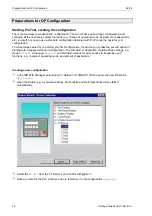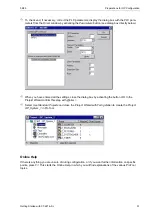
Programming Preparations
04/99
18
Getting Started with C7-621-AS-i
Setting the address areas and accessing the AS-i user data
In standard operation, the AS-i communications processor behaves like an I/O module. It occupies
16 input and 16 output bytes in the analog area of the controller. Each slave on the AS-i cable is assigned
four bits (a nibble) by the C7-AS-i-CP. The C7-CPU can access a nibble for reading and writing. The start
address of this address area is fixed at 256 in the C7-AS-i. For the assignment of the slave I/O bits to the
I/O bytes of the C7-CPU, see the AS-i interface table.
Assignment table
I/O-byte number
Bit 7-4
Bit 3-0
I/O byte number
Bit 7-4
Bit 3-0
256
reserved
Slave 1
264
Slave 16
Slave 17
257
Slave 2
Slave 3
265
Slave 18
Slave 19
258
Slave 4
Slave 5
266
Slave 20
Slave 21
259
Slave 6
Slave 7
267
Slave 22
Slave 23
260
Slave 8
Slave 9
268
Slave 24
Slave 25
261
Slave 10
Slave 11
269
Slave 26
Slave 27
262
Slave 12
Slave 13
270
Slave 28
Slave 29
263
Slave 14
Slave 15
271
Slave 30
Slave 31
Bit 3 I Bit 2 I Bit 1 i Bit 0
Bit 3 I Bit 2 I Bit 1 i Bit 0
Bit 3 I Bit 2 I Bit 1 i Bit 0
Bit 3 I Bit 2 I Bit 1 IBit 0
The parameters required in the application appear on a gray background.
The diagram below illustrates the access to the input and output data of the individual slaves.
Because the bits of the AS-i line can only be accessed in word mode or doubleword mode, it is necessary
to set up a memory data block. In the data block the AS-i data can be accessed in bit mode.
Transfer the image of the AS-i
input data to a data block.
Evaluate individual bits and
perform, e.g., logic operations,
setting and resetting, arithmetic
operations and counting.
Copy the output data of the data
block to the AS-i output data.
Cycle
Start of program
Program
End of program
















































